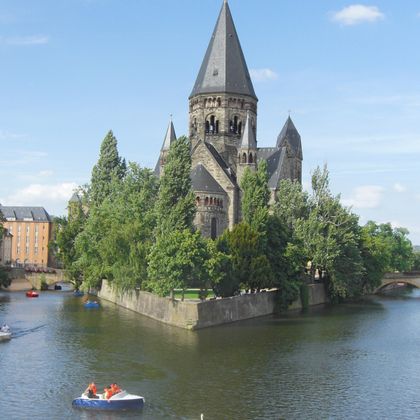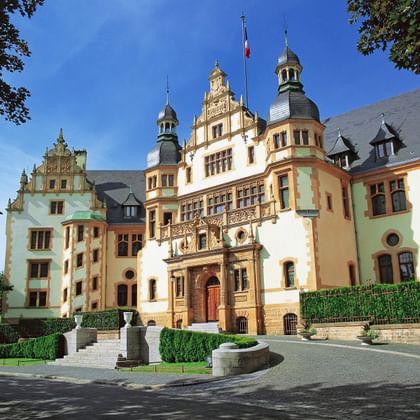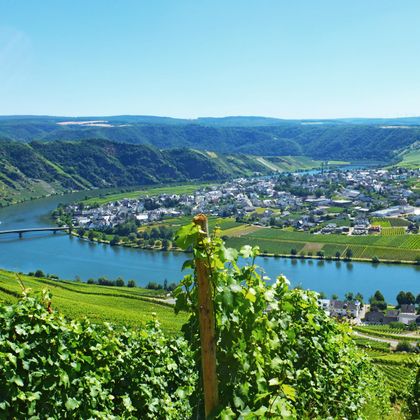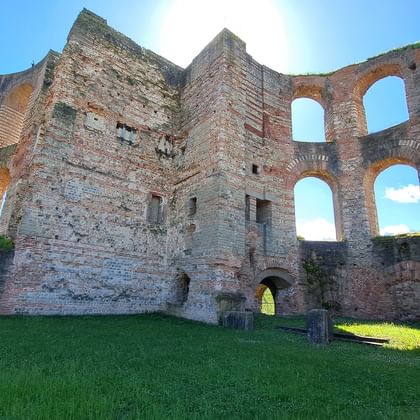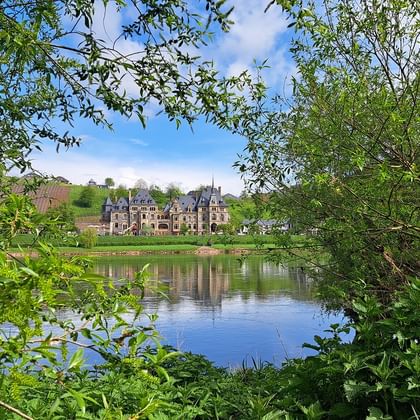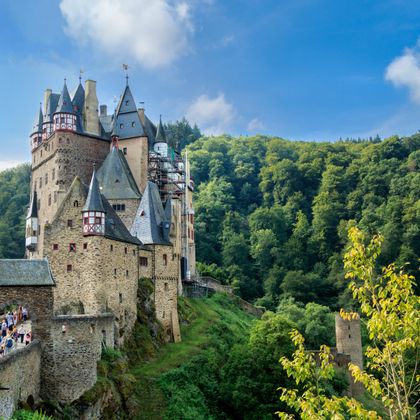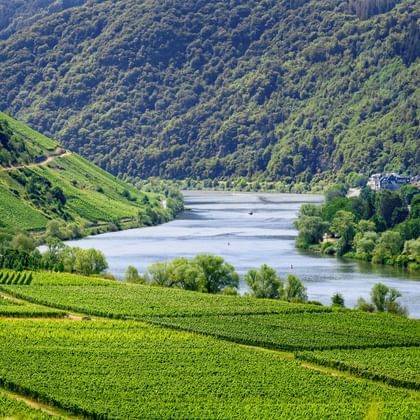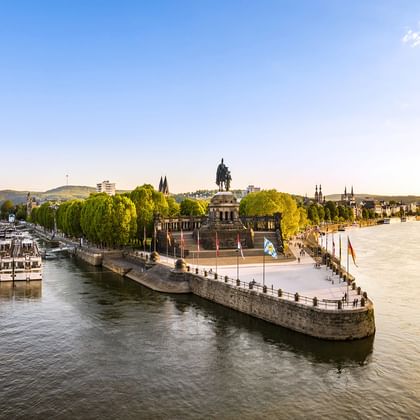Tour
Individual arrival by car or public transport to Metz. Arrive in time, because the capital of the Lorraine region is worth a visit and has something to offer! From the Roman era to the present, the city has unique monuments and is famous as a bishop's seat, university town and center of contemporary art. In addition to numerous sights in the old town, several extensive parks invite you to rest and relax, as well as the old restored fortifications of the city are worth a visit. Visit the Musée de la Cour d' Or, a building named after the legendary palace of Merovingian Kings, which once stood there. In the center you will find a variety of good and individual restaurants, with different culinary offers.
Almost the entire day you spend in France. On the way, spoil yourself with the famous French cuisine and enjoy a good 'cafe au lait'. If you want to reduce your kilometres please take the train from Metz to Thionville (direct connection, complimentary bicycles). From Thionville, you enjoy reliable and good signage and you will cycle very close to the water till the Franco-German border. Just over the border on German soil you have reached Perl and you can ferry to Schengen (other side of the Moselle/Luxembourg), known by the European agreement, which makes the free movement of regulated commodities or passengers possible or a nice bike ride to the Roman Villa Borg (5 km east of Perl). You'll marvel at the excavations, the reconstruction of the manor house and villas bath, the new system of ancient Roman gardens and enjoy a refreshment in the Roman tavern.
Today you will accompany the vast vineyards right and left of the Moselle for the first time. Take a trip to Remich, where you can feel the Mediterranean flair in many cafes and bistros along the 3 km long Moselle promenade. Give some extra attention to the place called by the Romans Remacum, and marvel at the old streets and the decanal Church from 1817. Take a trip to the Moselle terraces before you continue your way on the right bank of the Moselle. You cycle till Konz where you cross the mouth of the Saar and Mosel. From there it is not far to Trier and therefore you have time for a leisurely walking tour with a visit to the Porta Nigra, the amphitheater, the Imperial Baths or the magnificent cathedral.
Today, Roman past and contemporary viniculture will meet. The Moselle bike trail leads you to Mehring, where the Villa Rustica waits for your visit. ‘Villa Rustica’ is the designation for a manor in the Roman Empire. Today, the reconstructed walls and foundations can be visited again. You will cycle to Trittenheim, where a nature trail informs about the man-year of the vine-grower, the local variety of grape and the process of vine-growing. Just before reaching today’s destination, you will pass Neumagen-Dhron, Germany’s oldest wine-growing place! You should stop here to taste some of that wine!
The two famous Moselle towns Bernkastel-Kues and Traben-Trarbach and the well-known wine growing resort "Kröver Nacktarsch" are today’s highlight! Marvel at the colorful and manifold half-timbered constructions seaming the market place of Bernkastel-Kues. In Traben-Trarbach, you should take a boat trip.
You will discover Enkirch today, a jewel of the Moselle region’s traditional half-timbered architecture. Later on, you will reach Zell, the wine-growing resort with the ‚Zeller Schwarzen Katz’ (‚The Black cat of Zell’). Take a relaxing break in the small town of Beilstein, proud of its surname „Rothenburg an der Mosel“. Then, you will reach Cochem with its picturesque centre and the ancient realm dating from the 11th century.
Before the Moselle bike trail takes you to the neat wine-growing villages like Koben Gondorf or Winningen, which is one of the most beautiful villages in Germany and to the Deutsche Eck, you will have the chance to visit the medieval castle of Burg Eltz. The Burg Eltz is one of the most beautiful and best preserved castles in Germany. In Koblenz at the "Deutsches Eck" the Moselle flows into the Rhine. Enjoy the wide view over the magnificent valley of the Rhine and be looking forward to a wonderful evening in Koblenz.
Your bike trip ends in Koblenz today. Anyone who wishes to travel back to Metz should book our shuttle transfer. It will transport any luggage and the bikes as well. If you wish to cycle even longer along the Rhine, you can prolong your trip to Cologne.
Map
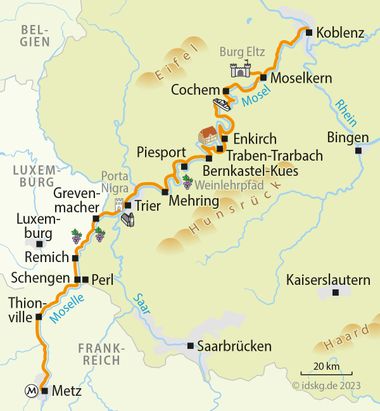
Prices / Dates
Services / Info
- Accommodation incl. breakfast:
Category A: Comfortable middle-class hotels, mostly in the center
Category B: partly family-run inns and smaller hotels, in Trier 5km away from the center (2025) - Room with shower/bath/WC
- Luggage transport
- Map of bike trails with marked route (2025)
- Digital route guidance via smartphone app for almost all journeys
- Tips for tour preparation
- Touristic information
- 7 days hotline service
Worth knowing about the bike tour Moselle: Metz - Koblenz
Below you will find specific and helpful information. If you have further questions about this trip, you simply call us: Phone: +49 (0)6421 – 886890.
Arrival by train
Metz is easy to reach by train. urrent schedule information and price information can be found at www.bahn.de
Parking facilities at the arrival location
Our contracted hotels in Metz are very centrally located in the city center and at the main train station and have hardly any private parking spaces. You can park your car for the entire duration of your trip in a nearby public parking garage. The cost per parking space per night is approx. 10,00€ (as of 2023). It is not possible to reserve a parking space in advance, but it is also not necessary. You will receive detailed information on parking facilities at the hotel you have booked with your detailed travel documents two weeks before the start of your trip.
Condition of cycle paths
The quality of the bike tail is very good. There are practical no unpaved or poorly developed path. The route runs almost exclusively on paved roads and is very well signposted. The volume of traffic varies, but between Trier and Cochem there is almost always a seperate bike trail on the right or left shore side, off the main road. Only during your last day you have to cycle a section on a wide bicycle lane next to the main road. Detailed information about which shore side is best to cycle on, you will receive together with the travel documents two weeks prior to departure.
Transfer back to the starting point of the journey
Every day at 9 am there is the possibility to transfer back to Metz with a small bus (with bike trailer). Arrival at 13.30 pm. The driver comes to pick you up at your hotel and has much room for you, your luggage and where required your own bicycle. The bus takes you back to your first hotel, thus ensuring a perfect return service without transfer and the hassle of hauling luggage.
Train and bus in the Moselle Valley
In the Moselle Valley runs not always a train. After Trier the train is leaving the Moselle Valley and the nearest station is not before Bullay. After only a few kilometres, the railway disappears in the Kaiser-Wilhelm-Tunnel and only reappears in Cochem. From Cochem the train runs completely in the Moselle Valley to Koblenz. From spring to fall, cycle buses with a maximum capacity of 22 bicycles run daily between Trier and Traben-Trarbach. Please note the respective conditions and possible transportation restrictions. Bus schedule information and Train schedule information
Boat trips on the river Moselle
From April to October there are many passenger ships on the Moselle. Boat docks are available in almost all places on both directions. Often tours are offered. Information about the exact departure times you find at the bulletin boards of the shipping companies.
A regular ferry traffic exists between Trier and Treis Karden.
Boat schedule information Moselle
Extra costs which are not included in the travel price
Any tourist tax and charging fees for bicycle batteries are not included in the tour price and must therefore be paid at the hotel.
7 day hotline service
Just in case the bike chain breaks, flooding makes it impossible to continue your tour or any other nasty surprise: You can reach us seven days a week and we will do anything to help you as fast as possible.
Passport and visa requirements
For EU citizens, there are no special passport or visa requirements and no health formalities to be considered for this trip.
Travel insurance
The tour price already includes the statutory insolvency insurance. In addition, we recommend that you take out travel cancellation insurance upon receipt of your travel confirmation in order to protect yourself against financial disadvantages in the event of travel cancellation, interruption of travel, illness or accident.
For this trip, we recommend using digital travel documents in the interest of sustainability. However, if you prefer, you can choose printed travel documents with a cycling map during the booking process. Please note that price differences may apply depending on your selection.
Available rental bikes
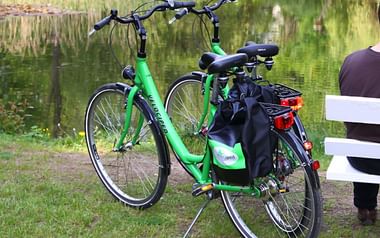
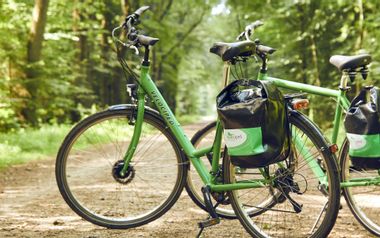
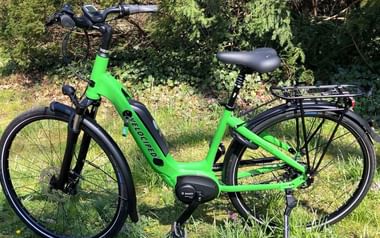


We would recommend the 7-speed tourer for all those that are looking for a back-pedal brake and wide gel seat for maximum comfort in an upright sitting position. It is equipped with a simple hub gear shift and is perfectly suited to tours on flat to slightly hilly terrain.

The 27-speed tourer is the best choice for cyclists that value the advantages of the dérailleur gear shift for flexibility whilst going up and down hills. This bike allows you to be a little more active without compromising on saddle comfort and practical everyday suitability.

E-bikes combine a lot of advantages. The electric drive ensures a completely relaxed cycling, even during long tours or on hilly routes. Other features, such as a suspension seat post and front fork plus well-tuned gears, ensure additional riding comfort.

On this trip, you can choose between e-bikes with a back-pedal brake or a freewheel. The e-bikes with a freewheel also offer you excellent riding comfort with a suspension seat post and front fork. Please simply indicate your preference when booking.

I provide you with advice and assistance
Nicole Henke
